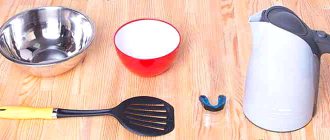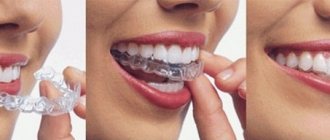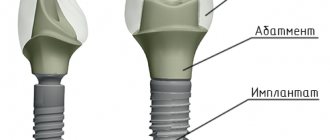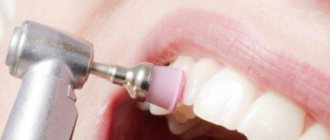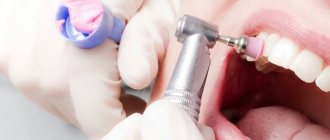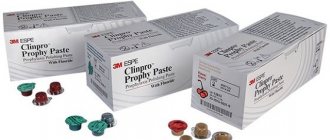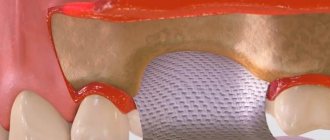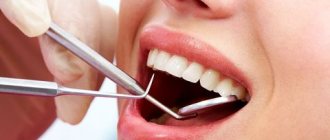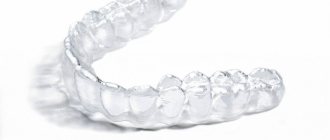Martial arts are one of the prestigious sports areas, thanks to which a young man turns into a real man. A sculpted body, the ability to stand up for yourself and your loved ones are not all the benefits that martial arts provide. However, along with the undeniable advantages of martial arts, there is a possibility of injury.
The teeth and oral cavity are primarily susceptible to injury. Without the use of special protective equipment (mouth guards), an athlete may end up missing a couple of teeth at the end of the fight, and the winner’s brilliant smile will be completely forgotten. In addition, mistakes made during a fight can remain forever on the athlete’s face if “protection” is not taken care of. In this article we will consider in detail issues related to one of the main elements of protective clothing - a mouth guard.
What is a mouth guard for?
A boxing mouthguard (cover, plate, dental caps, protective caps) is a special protective device that exactly follows the shape of the human jaw. A correctly selected and applied plate does not cause pain or discomfort to the athlete.
A mouthguard is one of the mandatory elements of sports equipment, without which a fighter is not allowed to fight. Its main purpose:
- protecting teeth from falling out or breaking;
- protecting the oral cavity from injury from a chipped tooth;
- protection of gums from cuts;
- preventing the biting of lips, tongue and cheeks during impact;
- reducing the risk of concussion;
- reducing the risk of cervical vertebrae displacement;
- partial protection against knockout.
Unfortunately, newcomers to the world of sports often realize the importance of a mouthguard only after they “lose” a tooth or two in sparring or a fight.
Wearing rules and care
To avoid damaging the device during use, you must follow the following rules and care for the mouth guard:
- Mouthguard in a special case
When removing aligners, always place them in a special case. It will provide the device with protection from mechanical damage, as well as suitable temperature and ventilation.
- You cannot eat or use chewing gum while wearing mouth guards. The same applies to most drinks: without removing the device, you can only drink clean, still water at room temperature.
- Mouthguards should be protected from temperature changes: they should not be left in direct sunlight, scalded with boiling water, kept near hot surfaces, or stored in the cold.
- It is advisable to remove the mouthguards while smoking: the material will quickly lose its flexibility, become cloudy, and may darken.
It's easy to care for your mouth guards:
- Each time after removal, rinse the device with running water.
- Clean your mouthguard regularly with a toothbrush and toothpaste.
- Use a special anti-plaque solution.
The history of the creation of the mouth guard
The reliable date of the appearance of the first mouth guard is unknown. However, many facts indicate that it was first used by boxers. Initially, athletes made this device themselves. They used cotton, wood and various ribbons as materials for modeling. The first plates were primitive and did not fit tightly on the teeth, so the fighters were forced to clamp such a mouthguard with their own teeth. This circumstance did not allow me to fully concentrate on the battle.
In 1892, dentist Wulf Kraus developed the first prototype of a natural rubber boxing mouth guard. They were attached to the upper incisors of boxers. Such a mouth guard was worn exclusively before the athlete entered the ring.
Philip Krause (son of Wulf Krause) is responsible for the development of reusable protective plates. One of these caps was given to Ted Lewis (Philip's school friend) before his fight with Jack Britton (1921).
However, there is other information about the appearance of the mouthguard. For example, dentist Thomas A. Carlos stated that he created the mouthguard back in 1916. He proposed his invention to Dinny O'Keeffe in 1919. Allen Frank claimed that, beginning in 1919, he made mouthguards in large quantities directly for boxers.
Until 1927, the use of mouth guards in boxing was prohibited. However, after the fight between Jack Sharkey and Mike McTeague, the ban was lifted. Such a dramatic turn in the world of boxing occurred due to the fact that Makting defeated his opponent throughout the entire fight. However, after a chipped tooth and a cut lip, the judge decided to remove him from the fight due to severe bleeding. It was this moment that became the precedent for making the mouthguard an integral element of the equipment of all boxers.
In 1947, Los Angeles dentist Rodney Liliquist was the first to make a mouth guard from clear acrylic resin. Such a plate completely copied the shape of the jaw, was tightly attached to the teeth and even allowed the athlete to talk. It was a real breakthrough. Since 1960, sports mouth guards have been used in all contact sports (football, hockey, acrobatics, equestrian sports, etc.).
Cooperation between Dial-Dent and the promotion company
The largest Russian promotion was organized by Russian businessman Andrei Ryabinsky in 2012. The company organizes and conducts boxing shows with the participation of world-famous boxing stars. The organization of the fight between Vladimir Klitschko and Alexander Povetkin - two great heavyweight boxers - in 2013 brought fame and worldwide fame.
The nice thing is that World of Boxing has not only the goal of making money from staging fights, but also has a great mission - to raise and develop Russian boxing to the world level. Holding fights in Russia and developing young athletes to the level of formidable professionals is the company’s priority.
Family Dental is a long-time partner. "Dial-Dent" as a partner participates in almost every event organized in Moscow. We have made boxing mouth guards for many athletes competing for this promotion company. We also provide athletes with quality dental care.
In the video below you can see the process of making a custom mouth guard for Georgy Chelokhsaev:
Types of boxing guards
Protective plates (mouth guards) are available in two types:
- single-jawed;
- two-jawed.
One-sided mouthguards (single-jaw) are placed on the upper jaw. This option is the most popular among athletes. This is primarily due to the fact that they do not make breathing difficult during a fight or sparring. Secondly, the athlete has the opportunity to talk, drink water, or, if desired, spit out saliva or liquid formed in the mouth.
Double-sided mouthguards (double-jawed) are aimed at protecting both the upper and lower jaws. In the world of martial arts they are less common due to their massiveness. Oxygen is supplied through special technical openings. The athlete's actions when using this option are greatly limited, but the protection is much higher. As a rule, this type of mouth guard is used by karatekas, and they are also recommended for female fighters.
Also, protective plates are classified according to the method of forming the groove (the place under the dentition). Regarding this criterion, sporting goods manufacturers offer the following options:
- Classic (cast). The trays are sold with grooves already prepared and ready for use. Disadvantage: the athlete must have an ideal jaw structure.
- Thermoplastic ones are a kind of blank, where, under the influence of temperature, the individual shape of the fighter’s jaw is set. This version of the mouthguard is very common among athletes.
- Individual (professional). Mouthguards of this type are made according to individual casts of the fighter’s jaw and depending on the bite. As a rule, this type of “protection” is used mainly by professional athletes. They are distinguished from previous options by their high cost.
The final result depends on the careful selection of the mouth guard. However, regardless of the price category, the mouthguard is aimed strictly at protecting the jaw.
How are aligners different from braces?
Both mouthguards and braces are used to correct bites in adults and children, but these designs have significant differences that determine both the disadvantages and advantages of each of them. To make it easier for patients to navigate in choosing the appropriate correction method, below is a table with a comparative analysis of both systems.
Aligners or braces
Table. Mouth guards and braces: comparison.
| Characteristics | Mouthguards | Braces |
| The effectiveness of bite correction | Effective only for minor bite pathologies. | Can be used for severe deformation of the dental system (including severe and complicated cases). |
| Wearing period | From 8-10 months to 2 years. | From 1 year to 2-3 years. |
| Possibility of use in childhood | Can be used in childhood (treatment of bruxism using silicone teethers is especially common). | It is acceptable to use in children over 5 years of age, but the possible risks of enamel damage must be taken into account. |
| Visibility to others | Mouthguards are made of transparent silicone or bioplastic and are practically invisible on the teeth, which makes their use more comfortable and provides psychological comfort to the patient. | Vestibular braces, which are installed on the front surface of the teeth, are clearly visible to others. If these are ordinary metal braces, wearing such a design can cause emotional distress for the patient (especially children and adolescents). |
| Comfort to use | Adaptation to the aligners usually occurs almost immediately after installation. In rare cases, this process may take 3-5 days. | Nagging pain and discomfort when wearing braces can appear at any time as the teeth gradually shift. The duration of such periods can range from 2-3 days to several weeks. |
| Degree of gum trauma | Due to the soft materials, the mouthguards practically do not injure the mucous membranes and soft tissues of the oral cavity. | Braces can have a destructive effect on tooth enamel and damage the mucous membranes of the tongue, lips and gums. |
| Possibility of removal without visiting the dental office | Maybe. | Impossible. |
| Ease of hygienic care | The mouthguard can be easily removed from the mouth to clean the teeth and the structure itself, which ensures a high level of hygiene during orthodontic treatment. | The level of hygiene when using brace systems is quite low due to the inaccessibility of surfaces covered with orthodontic brackets and locks. |
| Price | From 6 to 15 thousand rubles for one mouth guard. | From 70,000 rubles. |
At first glance, it may seem that treatment with mouth guards is a cheaper option compared to braces, but this is not the case. Aligners must be changed regularly, and one set can contain up to 25-30 drops per course of treatment. The total cost of the course is usually more than 200 thousand rubles.
Diagram of the results of treatment with mouthguards
We invite you to read: Chronic periodontitis treatment - Dr. Dent
What materials are the protection plates made from?
Every athlete sooner or later faces the question: “What material is better to buy a mouth guard from?”
- The most inexpensive are mouthguards made of latex or rubber. As a rule, cast plates are made from this material. Professional athletes do not use such mouthguards due to their inability to reliably protect against serious injuries.
- The average price option is plates made of silicone. They are boiled, and therefore are able to take into account the anatomical features of the athlete’s jaw. These mouthguards are used by mid-level fighters.
- Mouthguards for professional athletes are made from gel-like materials. This material allows you to accurately copy the shape of the athlete’s jaw, and during the fight it provides a high degree of protection.
It is also worth noting that a number of requirements are imposed on the mouth guards of professional fighters. If the plates used by the athlete are not able to provide the fighter with a certain level of protection, then the athlete is simply not allowed to compete.
Popular questions
Can a mouthguard be used instead of braces?
Mouthguards are used to correct malocclusions, but they are not suitable for all clinical cases. Serious anomalies cannot be corrected with their help: this requires braces or a combined approach, in which plates are used only at the final stage of treatment.
The mouth guard is cracked, what should I use to seal it?
You should not try to repair or seal a cracked or chipped mouth guard yourself: a broken device can damage your teeth. If you find mechanical damage to the mouthguard, you must stop wearing it and consult your doctor.
The process of “cooking” the mouth guard. Why is this necessary?
The “cooking” process involves adjusting the protective plate to the characteristics of your jaw. As a rule, thermoplastic mouth guards are subject to “cooking”. The packaging of this protective element contains detailed instructions for its preliminary preparation before use.
Each manufacturer has its own characteristics, but in general the order is approximately the same:
- Boil water;
- Place the mouth guard in boiling water for 20-25 seconds;
- Remove the plate and cool slightly;
- Bite the mouthguard with your teeth;
- Remove the plate after 3-5 minutes;
- Place the resulting “protection” in cold water.
After the procedure, the plate should accurately replicate the features of the jaw. If an unsatisfactory result is obtained, the process can be repeated again.
Reviews
Lyudmila, Penza: Recently my braces were removed and I was given a mouth guard as a retainer. I wear it only at night - I can’t wear it during the day due to the nature of my profession, but all the teeth are in place, there is no curvature.
Victor, Saratov: They straightened my son’s teeth with braces - he was terribly embarrassed. We talked with the dentist, and he allowed me to order mouth guards for the final stage of treatment. It turned out to be expensive, but we were pleased: he is comfortable to wear, and they are not visible at all, so he enjoys going to school with them.
Evgenia, Moscow: When I first put on mouth guards after braces, I had a slight lisp at first, but it quickly went away. I carried it for 4 months instead of the prescribed two, just in case. I was terribly tired of constantly brushing them, but otherwise there was no discomfort, and all my teeth were straight.
When wearing mouthguards, the main thing is a systematic approach and compliance with the rules of care. In this case, the device will help you go through the retention period quickly and without any discomfort.
How to use a mouthguard?
Thermoplastic plates can only be used after being “cooked” and adjusted to fit your own jaw. If you do not follow this order, then the mouthguard will be of no use. Molded protective caps can be used immediately after purchase. When using a mouth guard, you must adhere to a number of conditions, namely:
- The thermoplastic trays have special tongues, the main purpose of which is to help with immersion and removal during “cooking”. Before using such plates, the “tongue” must be cut. Otherwise, the athlete may get injured because of it.
- When the mouthguard is correctly put on, the jaw closes to a stationary state. The plate used should not change the bite or cause discomfort. If at least one of the listed signs is present, the use of a mouthguard is not recommended.
- The teeth and gums should fit snugly into the “grooves” of the mouth guard. The loose position of the plate in the mouth with clenched teeth indicates that it was chosen incorrectly (not in size). It is better to refuse such a mouth guard.
- Protective plates should not be worn over dentures.
- If the fit of a thermoplastic mouth guard is unsuccessful, the procedure can be repeated a couple more times to achieve the desired result.
A mouthguard is not a durable element of protection, so it must be changed periodically. In addition, the need to replace it is indicated by the appearance of an unpleasant odor.
Features of use
Fixed retainers
Why wearing mouth guards is convenient:
- they are completely transparent and therefore almost invisible;
- do not cause significant speech defects;
- the patient quickly adapts and ceases to feel the presence of the device;
- the materials from which the structures are made do not injure the oral cavity and do not cause discomfort.
Possible problems:
- may cause mild discomfort;
- defects in the pronunciation of hissing sounds;
- difficulty putting on mouth guards, feeling of squeezing, pain;
Minor speech defects and discomfort occur only during the first time after starting to wear them and quickly disappear. Some patients find it difficult to wear aligners for long periods of time and sometimes need to remove them to rest. This is undesirable, but not prohibited.
It is important not to stop using aligners for a long time, since after 1-2 days the dentition will begin to return to its previous position. It is because of this that mouth guards can be difficult to fit on teeth and cause discomfort.
Requirements for a mouth guard
When choosing a mouthguard, you should be guided not only by personal preferences, but also take into account all the requirements that it must meet:
- It is prohibited to purchase and use a red mouth guard in martial arts. This is due to the fact that the judge and doctors must be able to determine the degree (severity) of the fighter’s injuries without stopping the fight.
- A high-quality mouth guard should not have any odor or taste.
- A correctly selected plate does not interfere with speech or make breathing difficult.
- It is forbidden to use a mouth guard that “dangles” in the mouth.
- A precisely fitted mouth guard will not fall off when you unclench your teeth.
- The mouth guards used in martial arts are different from the mouth guards used by hockey players, for example. The plates are also divided into male and female. This fact should be taken into account when choosing a mouth guard.
- You should not purchase protective equipment from dubious brands.
Compliance with the above requirements will allow the fighter to minimize losses from the furious blows of his opponents.
Choosing protection for a child
A children's mouthguard is different in size from an adult's. Manufacturers produce two types of earbuds.
Children's – up to 10 years old, for a child under 140 cm tall. Adult – over 10 years old, for an athlete taller than 140 centimeters.
If the mouthguard turns out to be large, then the size is adjusted after “trying on”. Cut the long ends of the plate with a sharp knife or blade. If necessary, the protector can be “cooked” again.
The OPRO company produces special mouth guards for children . Professional orthopedists take part in the development of new models.
If your child has braces, purchase a specialized mouth guard. It’s called “for braces.”
What are mouthguards
Mouthguards are removable jaw pads made using special technology from durable, elastic silicone. They tightly cover the entire row, completely repeating its individual shape and taking into account the micro-mobility of the teeth. By exerting imperceptible pressure, the aligners gradually bring the teeth to an anatomically correct position. During the entire course of treatment, the structures have to be changed several times so that the pressure increases in several stages.
Mouthguards are safe for health, are not a source of allergies, and do not affect the enamel. Comfortable and painless to wear, absolutely invisible during communication. Easily removed from the mouth while brushing teeth or eating.
How long to wear dental aligners?
Typically, to eliminate orthodontic problems, dental aligners need to be worn for six months to two years. In complex cases, treatment can take up to 3 years. The duration of wearing is determined by the doctor individually for each patient.
During this period, you will need to change 10-30 pairs of dental trays. Each design is replaced with a new one in accordance with the schedule agreed with the doctor. You must come for follow-up examinations at least once every 2 months.
Important! It should be remembered that after the last pair of trays are removed, a retention period follows. If you do not fix the teeth, they will return to their original position and then treatment will have to start from the very beginning.
